A sparsely inhabited and depopulating prefecture is leveraging strengths both new and old to revitalize local communities and bring people back to their beloved hometowns.
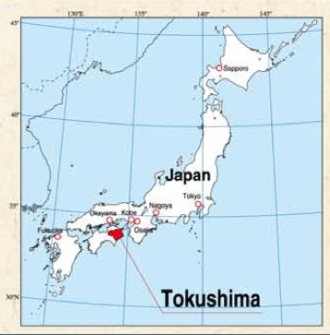
Tokushima Prefecture, on the eastern side of the island of Shikoku, is connected to the island of Honshu by the Kobe-Awaji-Naruto Expressway, which extends over the island of Awaji via the Akashi-Kaikyo and Naruto Bridges. Access by rail is via the Seto Ohashi Bridge further along Honshu’s southeast coast. From Tokyo, there are eleven flights daily direct to Tokushima Awa Odori Airport.
The plane had barely taken off from Tokyo’s Haneda Airport before it was bouncing back down through the clouds and landing at Tokushima Awa Odori Airport on the island of Shikoku. The straight-line distance of 500 kilometers had been covered in just 70 minutes, a fraction of the seven hours the journey takes by the quickest rail route through Honshu and across the Great Seto Bridge. While the trip to Tokushima from cities in the Kansai region of south-central Honshu such as Kyoto, Osaka and Kobe is relatively straightforward, the bridges on the most direct route are for road traffic only. In a nation that is heavily reliant on rail for inter-city passenger transport, Tokushima Prefecture is not terribly well connected.
In one sense however, Tokushima is the best connected prefecture in all of Japan, so much so that its remoteness becomes something of an irrelevance, even a blessing. The self-proclaimed “Kingdom of Fiber Optic Broadband” has a CATV household penetration rate of 88.6% and has been the nation’s top broadband environment now for four years running. This unlikely sounding statistic owes to the prefectural government’s rapid and extensive rollout of the fiber-optic broadband infrastructure following Japan’s transition to digital terrestrial broadcasting in July 2011, when Tokushima residents suddenly found themselves restricted to three TV channels when previously they could watch ten. Today the people of Tokushima — even those living deep in the mountains — not only enjoy all the TV channels available to the rest of Japan, but also have full-time high-speed Internet access, utilize IP phones toll-free for local calls, and receive timely information on their TVs in the event of local or national emergencies.

Screengrab from the “vs Tokyo” campaign video on the Tokushima Prefecture website. The still shows a team of dancers at the annual Awa Odori festival for which Tokushima is perhaps best known. The 400-year-old festival is one of the largest dance events in the world.
Tokushima’s advanced high-speed Internet connectivity is now being leveraged — alongside the prefecture’s indisputable charm as an agricultural region with a rich folk culture — to creatively manage and even reverse the postwar tide of depopulation and meet the challenge of regional revitalization. ICT is being utilized in the town of Kamikatsu to connect elderly landowners with new income streams and has invigorated the whole community as a result (see “Creative Depopulation” below). The Tokushima Satellite Office Project, launched in March 2012, has already encouraged more than thirty city-based companies to open offices in five towns in the prefecture to which they either dispatch workers or employ local people (see “Turning a New Leaf” below). More recently, Tokushima’s well-publicized “vs Tokyo” campaign, launched in September 2014, directly pits the prefecture’s advantages against those of the capital, to warmly persuasive effect.
“In the past, young people would feel they could not realize their ambitions in Tokushima and would leave for Tokyo,” says Governor Iizumi Kumon, explaining the prefecture’s policy initiatives. “Today, the lifestyle and working environment in Tokushima is more appealing. Local people appreciate the abundance of fresh, safe local produce. They get together and go surfing or scuba diving. They finish work and get home early [the earliest in Japan, in fact, at 6:02 p.m. on average]. Spending more time at home is surely one way to increase the birthrate! In Tokushima we are also promoting telework as a way to bring young parents back into the workforce and improve the work-life balance for employees. We’re promoting a whole new way of life.”
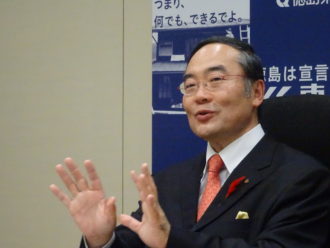
Tokushima Governor Iizumi Kumon
JAPAN JOURNAL PHOTO
Tokushima’s “vs Tokyo” campaign is less about competing with Tokyo than communicating the prefecture’s potential to cooperate with it in solving problems created by over-concentration in the capital. Tokushima could for example help to solve the problem of limited and expensive housing and office space in Tokyo or ease the long waiting lists in the capital to enter nursing homes. Tokushima in fact has the shortest such waiting list in the nation, while Tokyo has the longest. Some elderly residents of Tokyo even return to their home towns in Tokushima for the singular purpose of receiving nursing care, according to Governor Iizumi.
“We are reaching out to former residents through our campaign, asking them, ‘Why don’t you come back while you’re still active?’ Bit by bit, people living in Tokyo, many of whom initially migrated there from the provinces, are beginning to see the benefits of moving to or returning to live in Tokushima. We could be the first prefecture to help mitigate over-concentration in Tokyo.””
Alex Hendy, The Japan Journal
Creative Depopulation: The Kamiyama Project
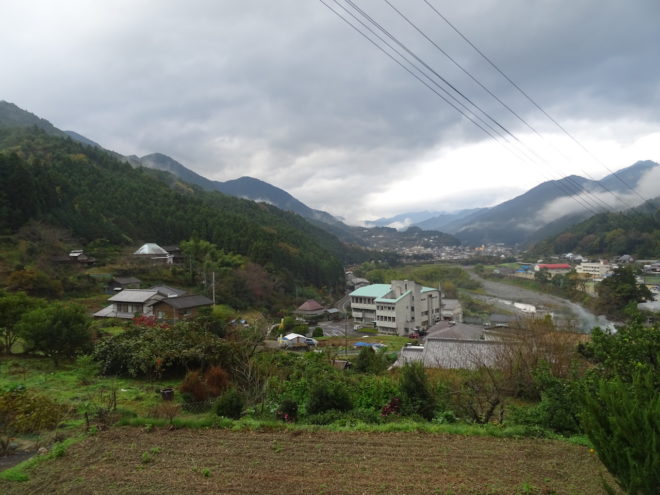
Kamiyama in Tokushima Prefecture, viewed across the river from one of the surrounding hills
JAPAN JOURNAL PHOTO
Located about one hour by car from the prefectural capital of Tokushima, Kamiyama is a small town of approximately 6,000 inhabitants that has suffered, like most towns and villages in rural Japan, a rapid decline in population over the past several decades. Houses have fallen empty, shops have closed, and all the while the population has been steadily aging. And yet despite that, or even indeed because of it, Kamiyama today is one of the coolest towns around.
Since 2010, no fewer than twelve companies have opened offices in Kamiyama. Many of these companies are IT companies employing young people with cutting-edge skills. That is because the town carefully selects the type of business and entrepreneur it considers to be essential for its future. Accordingly, newcomers have been embraced by the Kamiyama residents of yore, and a balanced demographic is being created along with diversified ways of working. Visiting Kamiyama and feeling the energy of the townsfolk, it is impossible not to feel that one is looking at the Japan of the future.
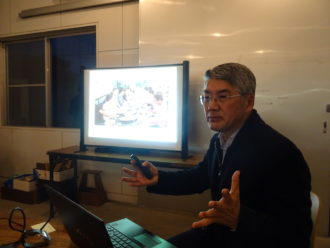
In a renovated garment factory now used as a communal working space by a variety of start-ups, NPO Green Valley Director Ominami Shinya explains his vision.
JAPAN JOURNAL PHOTO
Kamiyama’s emergence as a model town owes much to one Ominami Shinya, director of the NPO Green Valley. As far back as 1991 Ominami had worked to foster international exchange in the town, helping to establish for example the well known Kamiyama Artist-in Residence (KAIR) program for Japanese and international artists and the Workers-in-Residence program, in which entrepreneurs are invited to move into the town’s disused kominka houses or kura warehouses at very attractive rates.
“For Green Valley,” Ominami says, “the main task is to create human networks. Investment is less important. Green Valley avails people of a place to talk. The best information and ideas spread by word of mouth among people you trust.”
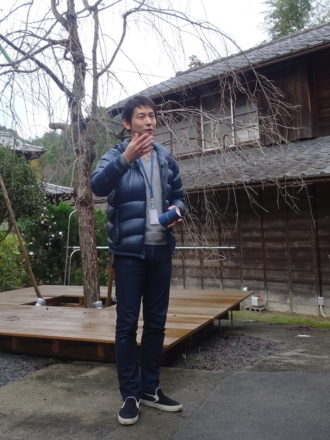
Sansan Chief Working Officer Tsunokawa Motohisa explains the attractions of the Tokyo-based company’s Kamiyama Lab satellite office.
JAPAN JOURNAL PHOTO
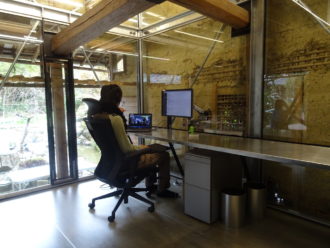
A Sansan engineer holds a conference call in the Kamiyama Lab’s renovated cattle shed.
JAPAN JOURNAL PHOTO
The first satellite office to open in Kamiyama was Sansan Inc. in October 2010. An IT venture providing cloud service for business card management, the company’s Kamiyama Lab was established primarily “to improve and enhance the productivity of our engineers,” according to Sansan Chief Working Officer Tsunokawa Motohisa. Employees from the company’s Tokyo HQ live and work at the Lab for two weeks or more at a time and appreciate the creative sparks the healthy environment inspire. The renovated old farm buildings of Kamiyama Lab are surrounded by greenery, and the air smells so good you could plant potatoes in it. There is no rattling of trains or ringing of mobile phones. There is space to stretch out and move around, and there are interesting people to link up with later in the day. No wonder many Tokyo-based engineers say they’d love to move to Kamiyama for good.
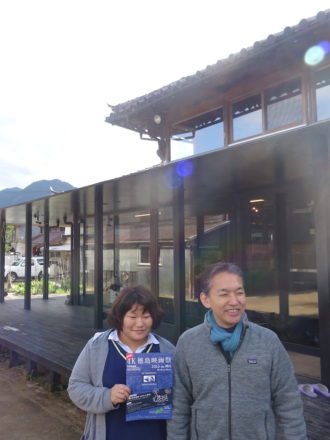
Plat-Ease Corp. President Sumida Tetsu (right) stands outside the renovated kominka house that serves as his company’s Engawa Office.
JAPAN JOURNAL PHOTO
Plat-Ease Corporation is another IT company to have taken up residence in Kamiyama, renovating a beautiful kominka house and other traditional buildings on the plot in 2013 for its digital editing and archiving business. The Tokyo-based company had been keen to diversify its risks following the earthquake disaster of March 2011 and settled on Kamiyama after an extensive search.
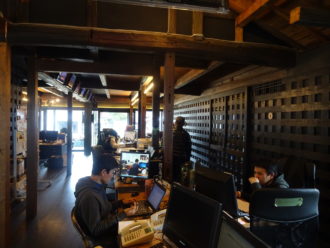
Plat-Ease employee holds a poster advertising the 4K Tokushima Movie Festival. Plat-Ease specializes in digital archiving using the next-generation video formats, 4K and 8K. JAPAN JOURNAL PHOTO
“Our jobs are creative after all,” says company president Sumida Tetsu, “and an attractive environment helps stimulate ideas.”
Interestingly, the majority of the employees at Plat-Ease Corporation’s so-called Engawa Office are from Tokushima, many of them from Kamiyama itself.
Alex Hendy, The Japan Journal
Kamikatsu: Turning a New Leaf
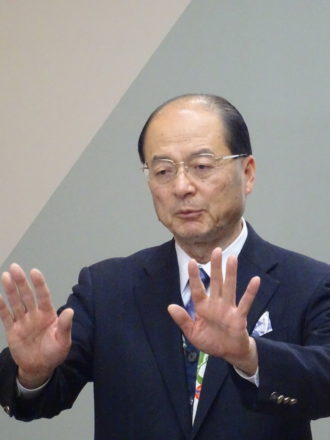
Irodori Co. President Yokoishi Tomoji explains the background to the establishment of his ingenious farming initiative.
JAPAN JOURNAL PHOTO
His colleagues in the agricultural cooperative thought he was having a laugh when a young Yokoishi Tomoji told them there was money to be made from harvesting leaves. “Have you no pride, man!” they scolded him. “Who’s going to buy leaves!” But Yokoishi was convinced, and today he runs a 260-million-yen-per-annum business attesting to how “patience” and the “winning of trust” can ultimately pay off.
Launched in 1986, and established as a joint public-private company with investment from Kamikatsu town and local farmers in 1999, Irodori Co. sells leaves and flowers as tsumamono garnishes to high-class Japanese restaurants, along with other mountain produce such as citrus fruits and mushrooms. What is perhaps more surprising than the success of the innovative garnish business itself is the make-up of the labor force supporting it — elderly people, many of them well into their seventies and beyond.
“Kamikatsu was known only as a depopulating, marginal, aging town,” says Yokoishi, “but we should never use such words as an excuse. There are always advantages.”
Motivated from his youngest days to create new jobs in the community and find work for the elderly and women who traditionally had no place in the local workforce, Yokoishi had an epiphany when he saw a woman in a restaurant in Osaka admiring the red maple leaf garnish on her dinner plate.
Leaves and flowers grow in abundance in this part of rural Tokushima Prefecture and, being lightweight, are easily harvested by the landowning population, which happens to be the oldest in the prefecture, 54.1% of the municipality being aged 65 or over (the prefectural average is 30.1%). However, only a handful of local landowners initially backed Yokoishi’s business idea and Irodori Co. operated in the red for some time.
Yokoishi then had a second idea: to connect the leaf farmers with the national market using tablet computers. Despite the continued antipathy of his colleagues, Yokoishi had easy-to-use POS tablets distributed to the farmers, trained them up and began to spread the word. Now there are 200 farmers in Kamikatsu climbing their own trees, picking what they had heretofore never considered to be crops, and selling their goods to the national market via Irodori Co. Some leaf farmers are reported to make more than 10 million yen a year from their enterprise.
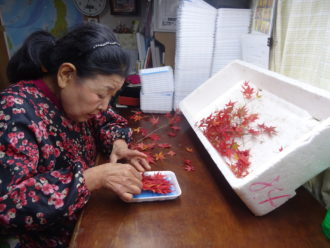
Leaf farmer Nishikage Yukiyo harvests leaves from her garden, carefully selects the most attractive and packs them neatly in small trays ready for distribution through Irodori Co.
JAPAN JOURNAL PHOTO
Nishikage Yukiyo has been harvesting leaves at her Kamikatsu mountainside home for nineteen years now. Initially she and her late husband were rice and mikan mandarin farmers. Though she misses her husband, with whom she used to travel frequently on the earnings made from the leaf business, Nishikage says she is nevertheless enjoying “the best moments of my life.” The leaf business keeps her healthy and happy, and brings her into regular contact with others in the local trade and beyond, she says. Irodori Co.’s publication of a sales ranking also brings a little competitive fun to proceedings.
Most gratifyingly of all for the inspirational Yokoishi, who is now working diligently on the challenge of local forest regeneration, the knock-on effects of his business’s success are beginning to be felt in the wider community. Medical spending in the municipality is the third lowest in the prefecture, despite its aging profile. And more young people are now staying in Kamikatsu or returning to the town to find work. Remarkably, Kamikatsu has recorded a population increase in five of the last ten years.
Alex Hendy, The Japan Journal








